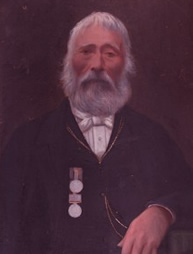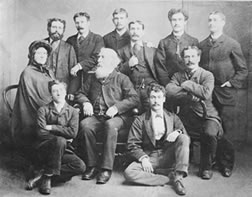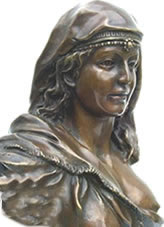 John Robert Lewis
John Robert Lewis
Sarah Wood was the grand-daughter of Abram Wood, and she married John Robert Lewis, a Welshman from Pentrefoelas in the Conwy Valley of North Wales. His family either worked the land or were craftsmen, but in 1815 John Lewis served as a soldier at the Battle of Waterloo. The story goes that he returned home from Belgium and was working in the fields when he saw dusky Sarah and the Woods walking near by. John was smitten by her, but both families opposed the marriage.
Finally, the Woods agreed under two conditions. Firstly, John had to fight for Sarah, bare-knuckled, against a cousin who also loved her. Secondly, he had to provide them with potatoes, dairy food and barrels of beer. John managed to fell the cousin and supply the produce so the couple were able to marry. Eventually, they had eight children.
John Roberts of Newtown, 'Telynor Cymru'
John and Sarah's eldest son was John Roberts, born in 1816, and he became the famous Harpist of Wales ('Telynor Cymru'). As a child, John travelled around Wales with his parents and the Woods. They slept in barns or tents and carried their possessions on horses and donkeys. Rivers were for washing in, supplying water for the kettle or yielding fat brown trout. Sarah walked door to door, telling good fortunes and improving her own at the same time, before meeting up with her family again at the next town. In the evening the men would play their harps in country kitchens, and local folk would gather round to dance and sing. As night fell and the stars came out, the Romanies would relax by a glowing stick fire, smoking pipes and telling stories into the dawn.
Well, that was the good times, and there was cold and hunger too. After one bad winter when he was 14 John joined the Royal Welsh Fusiliers as a drummer boy. Whilst enlisted, he improved his skills - as a harpist - such that he entertained young Princess Victoria in 1834 and '35. After nine years John deserted the army in order to marry Ellinor Wood, a great grand-daughter of Abram Wood. He spent the next four years playing in houses of the nobility and saving up the money to buy his discharge.
John won prizes for the harp at the 1842, '48 and '50 Eisteddfodau and also played for a Grand Duke of Russia and the King of the Belgians. In 1850 he moved to Newtown in mid Wales and brought up a family of musicians: thirteen children were borne to Sarah between 1840-65.
His eldest daughter, Mary Ann, quickly grew into a skilled harpist, and for many years she and her father entertained the public together. He also formed The Cambrian Minstrels with his nine sons. Between them all, they played the Welsh harp, English harp, violin, double bass, cello, flageolet and piccolo.

The Cambrian Minstrels spent Sundays in Newtown playing in the Bear Hotel or on the streets outside. During winter their bankside waltzes warmed skaters on the River Severn. Summertimes included a tour around North Wales, and whilst their instruments lounged in luxury on a pony-cart the musicians walked all the way. They would camp in tents near a river, fish during the day, and perform in the evening for a collection.
The Minstrels were also booked for upmarket celebrations throughout Wales, and their clients included the Duke of Bedford, the Duke of Westminster, Lady Llanover, and the Earls of Powys and Denbigh. John advertised his services as "the celebrated royal and imperial Welsh harpist" available for "balls, concerts, lawn tennis and private parties".
One son, Albert, was a notable Welsh harpist, and he and his father played for the visiting Empress of Austria. However, the prime occasion came in 1889 when father, nine sons, plus second cousin Edward Wood played before Queen Victoria at Pale Hall near Bala. John even sang solo to round off the evening. By now, he had been bestowed with the title 'Telynor Cymru' (Harpist of Wales).
Like many Welsh Gypsies, John could speak Welsh, English and Romani, but unlike most of them he could also read and write. In later years he corresponded with Francis Groome, who was the editor of the Gypsy Lore Society, and recalled his life in vivid terms. Groome published extracts from John's letters in his two books In Gypsy Tents and Gypsy Folk Tales.
The grand Harpist of Wales died in 1894 but left behind him many talented descendants. Of his thirteen children, three were girls: Mary Ann and Sarah both had children by their relative Edward Wood; Ann went unmarried. The ten boys were successively Lloyd Wynne, Abraham, Madoc, John, twins James and Reuben, Albert, twins Ernest and Charles, and William. Apart from Abraham (who died in childhood) they all survived into the 20th century, and in 1932 young William kept up the family tradition by playing for royalty at the London Palladium during a Royal Command Performance.
Information from The Welsh Gypsies and Teleri Gray.
Photographs courtesy of Teleri Gray copyright 2006.
Copyright Warning
All texts/audio/still/motion picture images are strictly copyright to ValleyStream Media 1980-2010 or to the stated contributor/
copyright holder/s or "unKn". Any unauthorised copying of any images or material from this website for any use is strictly prohibited without written permission from the image owners - owners of unknown images ("unKn") from this website please contact us for fair use or image withdrawal. All rights reserved.

